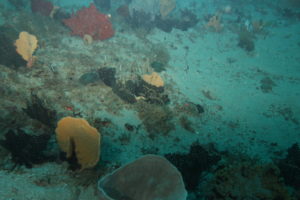Deep reefs (2015 – 2020)
The deep reefs of Ningaloo
Up until now research conducted on the deep reef habitats at Ningaloo has been limited. What we do know from the studies that have occurred is that these areas are likely to support abundant, highly diverse, filter-feeding communities – which are identified as important ecological values in the Ningaloo Marine Park’s Management Plan.
Information on abundance and taxonomic composition of these deep reef habitats, along with the ecological processes essential for their long-term sustainability (such as connectivity among areas), are key pieces of information needed to develop effective long-term management strategies for the area. As such, a key objective of the deep reef research theme for Ningaloo Outlook (2015 – 2020), led by Chief Research Scientist Dr. Russ Babcock, was to document the extent and character of deep water habitats at Ningaloo.
Ningaloo deepwater habitat observed during a survey – Sponge garden on sand covered low profile limestone reef.
Deep reef ecosystems (known as ‘mesophotic’ ecosystems because of the low amount of light that reaches the seafloor in deeper water) are extremely difficult to survey using conventional diver-based methods because of the risks to divers. A combination of CSIRO’s in-house Autonomous Underwater Vehicle (AUV) Starbug-X, swath-mapping and towed video techniques were used to locate and describe deep reef habitats, and to assess the year-to-year variability in the abundance and taxonomic composition of the biota that inhabit them.
Swath-mapping and video drops of deep reef locations at Ningaloo was undertaken at four locations (Tantabiddi, Helby Bank, Mangrove Bay, Osprey), with towed underwater video surveys conducted in targeted areas. A total of 62 square kilometres were surveyed by the team over the life of the project, along with over 50 video tows.
Analysis of the data found the main part of Ningaloo Reef (in the areas surveyed) extends to depths of around 35 m, with reef building (hard) corals rare or absent at depths greater than 25 to 30 m. At depths between 35 to 70 m, few reef structures were observed, with the biological communities observed predominantly sponges and octocorals. Extensive beds of shell gravel and crustose coralline algal nodules, and solitary corals were noted at the deeper depths. In 2017, the team discovered a community of more than 12 million mushroom-shaped corals in water depths of around 40 metres! The corals, called Cycloseris distorta, were found the perfect ‘Goldilocks Zone’ to prosper, not too deep, not too shallow, but just right. In the same survey the team also discovered an old anchor, something they didn’t expect to find!
Results from the deep reefs theme have improved habitat characterisation and mapping extent of deep water reef areas of Ningaloo, including the creation of a habitat map by exploiting the characteristic signals produced by sonar, coupled with data collected from video and AUV field deployments.
To find out more about the research findings from the deep reefs research theme, read our Ningaloo Outlook Highlight Report.
Future Scientists
A key element of the Ningaloo Outlook partnership was to provide training opportunities for future scientists. Joe Turner, our PhD Scholar for the deep reef research theme, investigated the ecology of deep water filter-feeding communities.

